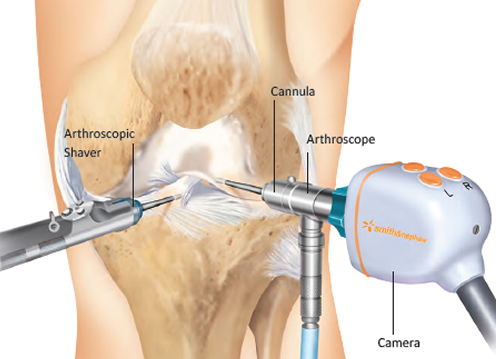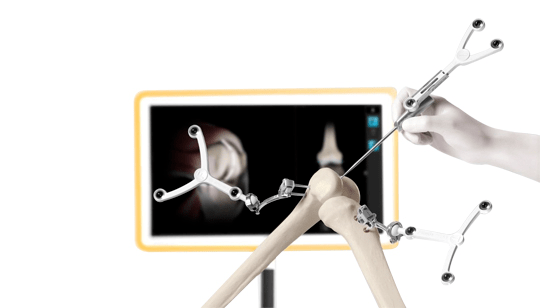An arthroscopy is a “key-hole” operation which is used to look inside of joints and is especially common with the knee joint. This is performed using a series of very small cuts in the skin, to make two or three small portals (holes) within the knee joint.
- The arthroscope (camera) is inserted into one of the portals.
- A second portal can be used to flow a saline solution through the knee joint, which improves visibility and manoeuvrability of the instruments.
- The third portal is for the arthroscopic instruments.
An arthroscopy allows the orthopaedic surgeon to examine the knee joint, which allows an accurate diagnosis and treatment to be carried out.


knee arthroscopy are a large number of different conditions that can cause symptoms within the knee joint. The main symptoms that typically might suggest that a knee arthroscopy could be necessary are:
- Pain in the knee (especially sudden sharp pain)
- Intermittent swelling (this is often associated with conditions such as meniscal tears)
- ‘Giving way’ (this is where the knee ligaments are damaged, causing instability, or it can be caused by loose or torn pieces of cartilage catching inside the knee)
- Locking (which can be due to cartilage loose bodies or unstable flaps from meniscal cartilage tears).
How is an arthroscop
Some of the operations, which can be performed at the knee using an arthroscopic approach include:
- Trimming or repairs of specialised knee cartilage (meniscus)
- Removal of loose bodies (cartilage/bone)
- Micro-fracture treatment for osteochondral defects (bone-cartilage defects)
- Reconstruction of ligaments
- Trimming of other soft tissues (ligaments, plica, and bursa)
- Release of soft tissue to correct patella tracking problems
Can there be an complications or risks?
As with any surgery there are risks involved. The consultant will inform you of these risks prior to your operation. These risks include:
- Bruising and swelling
- Infection
- No change or recurrence of symptoms
- Stiffness in the knee
- Unexpected reaction to the anaesthetic
- Damage to nerves and blood vessels possibly requiring further surgery
- Loss of feeling around the operation wounds
- Blood clots in legs and/or lungs, stroke, heart attack or heart failure, all which can result in death
- Complex regional pain syndrome which is an uncommon form of chronic pain. The pain usually develops after an injury which in most cases is a minor injury or surgery but the pain experienced is out of all proportion to what you would normally expect.
What happens afterwards?
Post-operative advice
- You should refrain from the consumption of alcohol or taking any medication other than that prescribed by the nursing staff (including sleeping tablets) for 48 hours.
- When you feel ready, you may eat and drink.
- You may return home once in a stable condition and the nursing staff have arranged your discharge medication and information.
- If you have had a general anaesthetic, we also advise you not to operate machinery or household appliances. We also advise that you have somebody drive you home and stay with you for the first 24 hours following the operation.
What to look out for
If you experience any of these symptoms following the operation you must contact the hospital immediately.
- Fever
- Cold sweats/chills
- Persistent warmth or increased redness around the knee joint
- Increased pain around the knee joint without a change in medication (pain relief)
- A significant increase in the amount of swelling at the knee joint
- A pain in the calf muscle with associated swelling and redness
Follow up with the consultant
Following the arthroscopy you may be visited by the consultant on the ward/day surgery unit for further assessment and to discuss the operation. A follow-up appointment will be sent out in the post, asking you to attend the outpatients department. This will be arranged for approximately 2 weeks following the operation.
Returning to work
This will depend upon the specific details of your operation and also the nature of your work. Usually at least one week off work is required, however this may need to be longer if your work is specifically manual/physical. This should be discussed with your consultant for further advice on this matter.
Return to exercise and sport
This will depend upon the specific details of your operation. This is something that should be discussed with the consultant or your physiotherapist.
Post-operative exercises
There are a wide range of exercises detailed within this leaflet, but these may be modified by the physiotherapist according to your specific operation.
Swelling control
It is generally advised that you elevate the leg on a regular basis for the first 48 hours after for operation. This will reduce the risk of swelling and pain.
As long as there is no reduced sensation at the operation site then an ice pack may be applied to the knee joint to reduce swelling also.
- Cover your knee with a damp tea-towel or cloth. It is important that ice is not applied directly onto the skins surface as this can cause an ice burn.
- Use either ice in a polythene bag (ice pack) or a pack of frozen peas.
- Place the ice pack over your knee, holding this in place with a towel.
- Leave the ice pack on for approximately 10-15 minutes, inspecting the skin on a regular basis.
- It is normal for the skin to become cold and slightly red. If there is a significant increase in pain then remove the ice pack immediately.
Walking normally
Generally you are allowed to walk full weight-bearing or as pain allows after the operation. If this is restricted to either non-weight bearing or partial weight bearing then this will be assessed prior to your discharge.
It is important to try and walk normally.
- The first part of the foot to make contact with the floor should be the heel and last part of the foot to leave the floor should be the big toe as you push off.
- Try and place one foot in front of the other as you walk.
- Try and bend the operated knee as it swings through.
Stairs
When going up the stairs, it is easier to lead with the unoperated leg taking one step at a time.
When coming down the stairs, it is easier to lead with the operated leg, again taking one step at a time.
